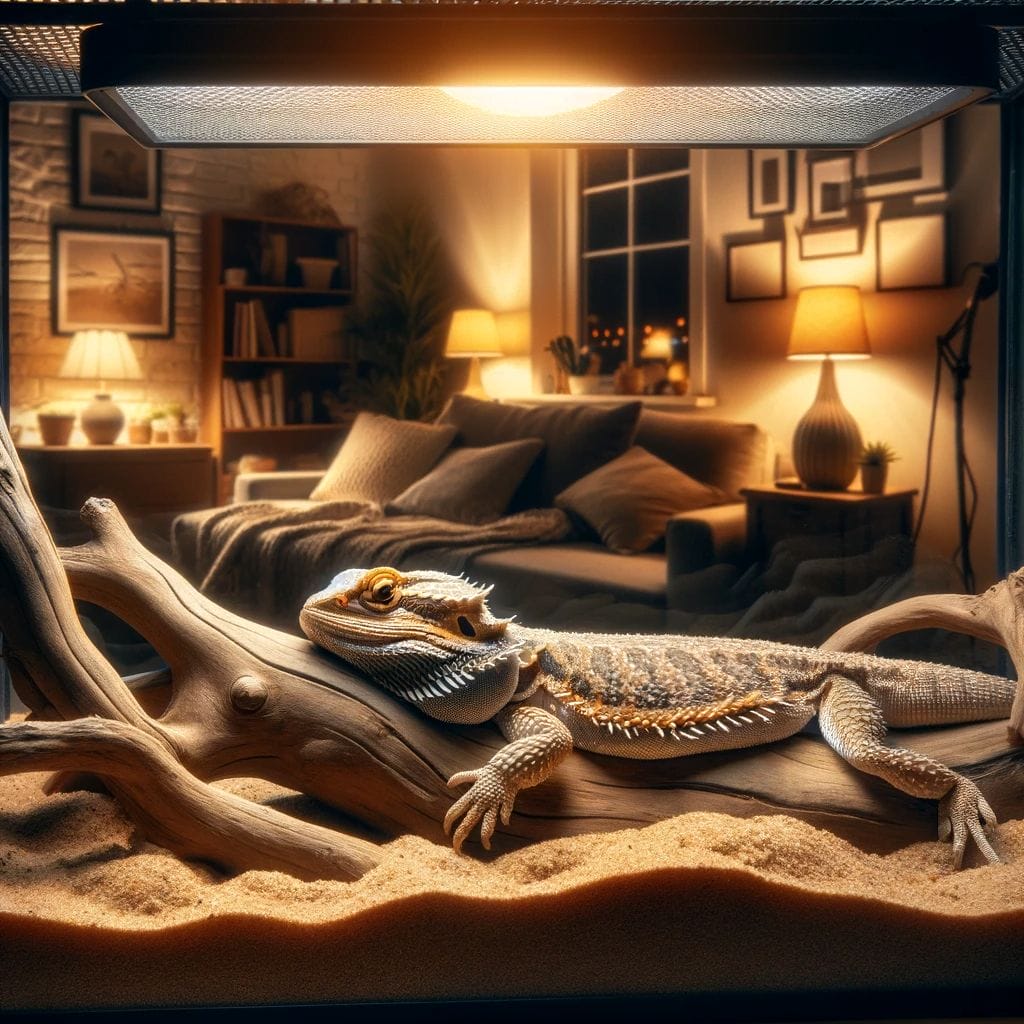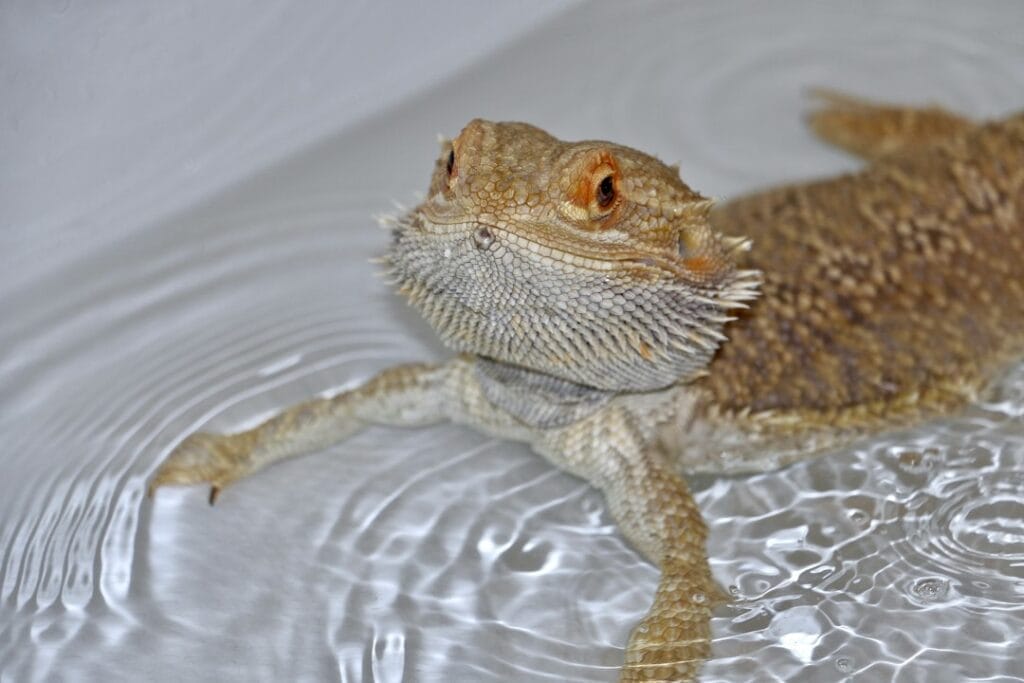Imagine your living room a little wilder with the presence of a bearded dragon basking under its lamp. That’s right, these charismatic reptiles are turning heads and warming hearts as they climb their way to being one of the most beloved pet choices among enthusiasts. With personalities as distinct as their spiky visages, bearded dragons offer an unparalleled peek into the world of exotic pet care.
You’re about to dive deep into everything from setting up that perfect habitat – think warm basking spots and cozy hiding areas – to figuring out what exactly these critters crunch on for dinner. And let’s not forget to ensure they stay in tip-top shape; we’ll touch upon those vet visits and health checks essential for any thriving bearded buddy.
Come along as we unfold this guide packed with must-knows that will have you prepped and ready for life with your scaly sidekick!
Table Of Contents:
- Types of Bearded Dragons as Pets
- Creating a Suitable Habitat for Your Bearded Dragon
- Understanding Bearded Dragon Diet and Nutrition
- The Lifespan of Bearded Dragons in Captivity
- Health Care Essentials for Bearded Dragons
- And Now You Know
 AI Illustration of a Bearded Dragon
AI Illustration of a Bearded Dragon
Types of Bearded Dragons as Pets
If you’re eyeing a bearded dragon to join your family, you’ll find that the Central Bearded Dragon is the top dog in popularity. This scaly friend hails from Down Under and has made quite a name for itself among pet enthusiasts. With eight recognized species, these reptiles come in an array of variations and morphs, each flaunting unique characteristics.
Apart from their captivating looks, what makes them such great pets? Well, they’ve got personality. From the laid-back vibe of some to the more animated antics of others – think head bobbing and arm waving – there’s never a dull moment with these critters around. If size matters to you, know this: adult Central Bearded Dragons can grow up to 60 cm long but don’t worry, even at full tilt, they manage their space well.
Their adaptability doesn’t end there; when it comes to setting up shop for your new buddy, proper care ensures they thrive in captivity. Mimicking their natural habitat goes far beyond aesthetics—it’s about creating comfort zones where temperature regulation plays a hero because let’s face it: no one likes being cold-blooded without some cozy heat sources.
Creating a Suitable Habitat for Your Bearded Dragon
Your bearded buddy deserves the best, and that starts with a habitat that’s just like their natural home. You wouldn’t want to live in a shoebox, right? So, let’s make sure your dragon has space to roam. The ideal tank size for an adult stretches about 4 feet long by 2 feet wide by 2 feet tall – giving them room to explore without feeling cramped.
Now imagine you’re lounging on the beach; it feels good, doesn’t it? That’s how your dragon should feel under their UV light. It’s not just there for show; UVB light is crucial for their health, helping them absorb calcium and avoid metabolic bone disease. Pair this with some basking spots using external heat sources where they can soak up those rays at around 100°F – but don’t forget cooler areas too. A gradient of temperatures lets them regulate body temperature perfectly.
A varied landscape makes life interesting. Think rugged outback with rocks, tree branches, and hiding areas so they can play hide-and-seek all day long. And because hydration is key, always have clean water available in a shallow dish – we’re talking pinky fingernail deep here.
Get everything you need to make your bearded dragon feel right at home.
Understanding Bearded Dragon Diet and Nutrition
Bearded dragons have appetites as spiky as their namesakes, gobbling up a balanced diet of vegetables and insects like they’re at an all-you-can-eat buffet. Mealworms, crickets, and roaches aren’t just the creepy crawlies you shoo away; for these reptilian pals, they’re gourmet treats that keep them healthy. But it’s not all about the bugs—leafy greens should also take center stage in your bearded dragon’s diet.
A well-rounded menu isn’t just good manners; it’s critical to prevent issues like metabolic bone disease—a real party pooper for any dragon. Just think of calcium-rich collard greens as the kale smoothie of the lizard world—they might turn their nose up at first, but trust me, they’ll thank you later when their bones are tough enough to arm wave without breaking a sweat—or a bone.
Your scaly sidekick needs more than food to thrive; heat sources mimic those sunny rock perches in Australia—their homeland—and help regulate body temperature so digestion runs smoother than a gecko on glass. Remember that young bearded buddies grow faster than bamboo shoots on steroids—so keep those cricket feeders busy. By following proper care guidelines, expect your dragon pal to stick around for 8-12 years or even score tickets to their second decade.
The Lifespan of Bearded Dragons in Captivity
When you bring a bearded dragon into your home, you’re signing up for a long-term friendship. These scaly pals can stick around for an impressive 8 to 12 years on average, and with stellar care, some have been known to hit the two-decade mark. That’s right—20 years of head bobs and arm waves.
To give your dragon the best shot at a lengthy life, think about their setup like it’s their kingdom. It all starts with getting their habitat just right; they thrive when they’ve got space to roam. Adults need at least a 4-foot-long tank where they can lounge under UV light or hide away in cool spots when they feel like chilling out.
Nutrition is another cornerstone of bearded dragon health. A balanced diet that mirrors what these creatures munch on in the wild keeps them spry and satisfied. We’re talking leafy greens packed with vitamins—not iceberg lettuce, though—and live insects that make mealtime an exciting hunt (just imagine crickets as tiny fast food). Always keep clean water handy, too, because hydration is key.
Health Care Essentials for Bearded Dragons
Caring for a bearded dragon isn’t just about serving up a buffet of crickets and basking in their prehistoric glory—it’s also about keeping them healthy. Think of it like this: Just as you wouldn’t ignore your own health, don’t neglect your scaly sidekick’s need for veterinary care.
Regular check-ups with a vet who knows reptile pets inside out can catch issues early on. It’s crucial because when something is off with your bearded buddy—like if they start doing the arm wave more than usual—it could signal dominance or distress; context matters. A good vet will help decipher these behaviors and provide treatment plans that might include pain management or alternative therapy options to keep them feeling like royalty.
Sometimes, trouble lurks where we least expect it, such as metabolic bone disease—a common villain due to insufficient UV light exposure—or other dietary missteps. So make sure you’re up-to-date on what dragons eat (hint: leafy greens should take center stage over live insects). Also, keep an eye on body temperature; without external heat sources dialed in just right, things can go south faster than lizards at a desert disco. Don’t forget hydration, too—always have clean water available in their tank via a shallow dish so they can sip at leisure without taking an unintended swim.
To learn more about how regular veterinary visits contribute significantly to bearded dragon health, click through our photo gallery showcasing our happy patients benefiting from cutting-edge treatments like laser therapy and thermal imaging.
If you have questions about the health of your bearded dragon, you can sign up for an online vet consultation with Ask a Veterinarian. They are available 24/7 to answer questions. To avoid unexpected health costs, check out Pet Assure Mint.
And Now You Know
So, you’ve stepped into the world of bearded dragon care. Remember, a happy pet starts with their home. Mimic that natural habitat—space to roam and spots to hide are key.
Nourish them right; a mix of greens and insects does the trick. Keep it varied for your bearded buddy’s best health.
Your scaled friend can share years with you—up to a decade or more—with love and proper care.
Vet checks? Non-negotiable. They’re vital for catching those sneaky health issues early on.
You’re all set now! A bit of knowledge goes far in making sure your bearded dragon not just survives but thrives by your side.

